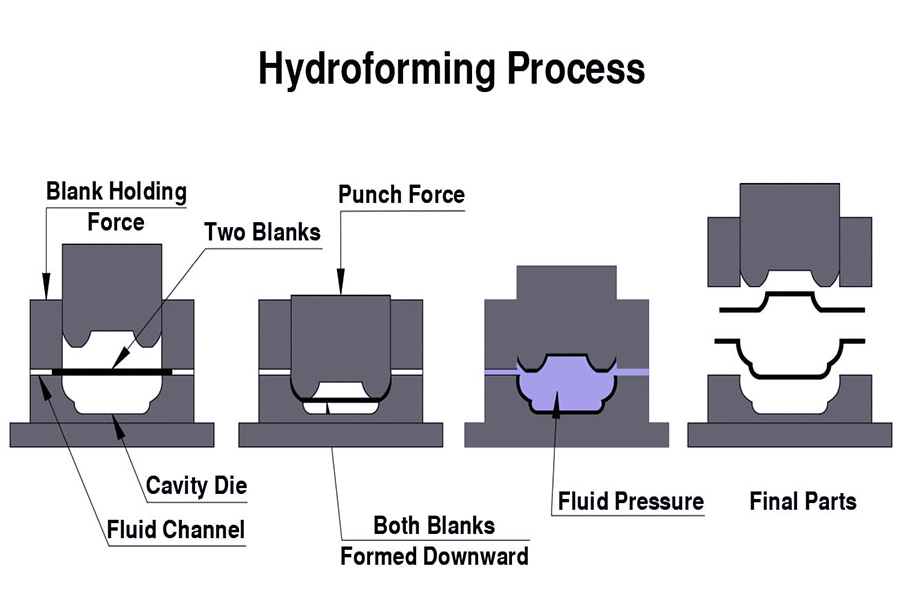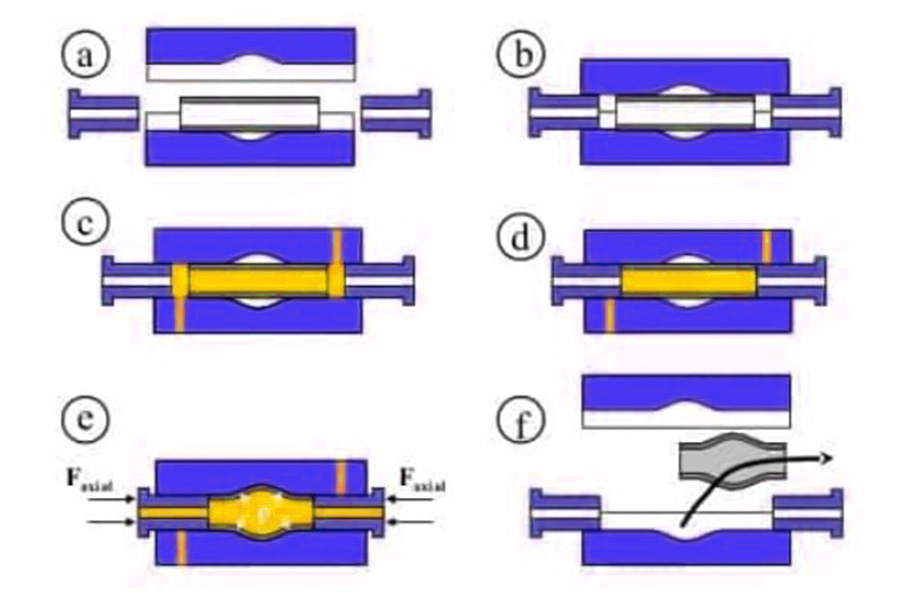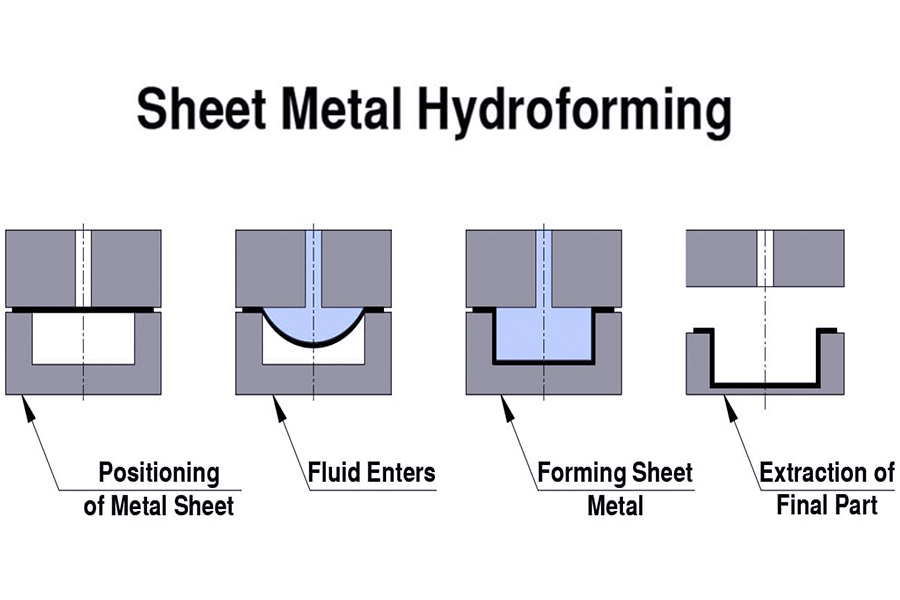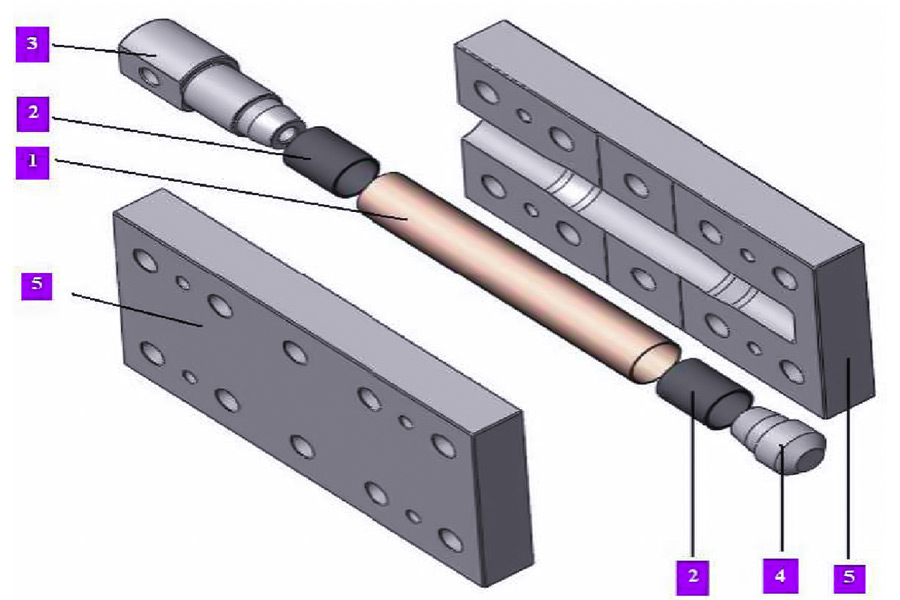Hydroforming, also known as liquid formingor internal high pressure forming, is an advanced metal forming technology. It uses liquid as a force transmission medium to replace the traditional rigid punch or die to apply pressure to the material to cause plastic deformation to achieve the desired shape. This technology is widely used in aerospace, automobile manufacturing, and household appliances, and is particularly good at achieving lightweight structures.
This article will explore the specificprocess of hydroforming, including its classification, process steps, advantages and disadvantages, and advantages and challenges in practical applications. Let's start today's learning journey!
What is hydroforming?
Hydroforming is a cost-effective and professional mold-forming metal fabrication and forming process that uses high-pressure hydraulic oil to form metals such as steel, stainless steel, carbon, copper, aluminum and brass into lightweight, strong and structurally sound parts. Almost any metal that can be cold formed can be hydroformed.Hydroforming can form complex shapeswith concave surfaces that would be difficult to achieve with standard one-piece die stamping.
One of the largestapplications for hydroformingis in the automotive industry, which requires complex shapes that are lighter, stronger, and stronger. This process is also often used to form aluminum tubes for bicycle frames. Other advantages of parts manufactured via hydroforming include seamless bonding and increased part strength. They also maintain a high quality and less grainy surface for easier metal finishing.
What Are the Steps in the Hydroforming Process?
Thehydroforming processis an advanced metal forming technology that is widely used in many fields such as automobiles, aerospace, and home appliances. The following are the mainsteps of the hydroforming process:
- Material preparation:Select suitable plates or pipes as raw materials, and perform necessary pretreatment, such as cutting and cleaning, to ensure that thematerials are suitable for hydroforming.
- Mold installation and debugging:Install the designed mold on the hydroforming machine and debug it to ensure the accuracy and stability of the mold, as well as the good cooperation between the mold and thehydroforming machine.
- Material placement and positioning:Place the pretreated material in the mold and accurately position it to ensure that the material can be evenly stressed and fit the mold during the forming process.
- Hydraulic pressurization and forming:Inject liquid into the mold and gradually increase the pressure of the liquid to make the material plastically deform in the mold until it reaches the desired shape and size.
- Pressure relief and demoulding:After the forming is completed, gradually reduce the pressure of the liquid and remove the formed part from the mold.
- Subsequent processing:Perform necessary subsequent processing on the formed part, such as trimming, deburring, surface treatment, etc., to meet the requirements of the final product.

How Does Tube Hydroforming Work?
Thetube hydroforming technology uses metal tubes as raw materials.Special hydraulic equipment is used to inject high-pressure liquid into the sealed pipe blank. At the same time, the axial punch is used to apply inward thrust to feed the material, so that the pipe undergoes plastic deformation in the mold cavity, and finally a hollow part of the required shape and size is obtained. The steps of thetube hydroforming processmainly include the following stages:
- Material preparation and placement:Select suitable metal pipes as raw materials, ensure that their surfaces are clean, free of rust and oil, and cut into appropriate lengths according to product requirements. Place the pipe in the lower mold and position it to ensure that one or both ends of the pipe are tightly connected to the sealing device of the mold.
- Mold installation and debugging:Install the designed upper and lower molds on the hydraulic forming machine and debug them to ensure the accuracy, stability and sealing of the mold. Thedesign of the mold needs to be based on the shape, size and performance requirements of the product.
- Liquid injection and sealing:Inject an appropriate amount of high-pressure liquid (such as water, hydraulic oil, etc.) into the tube through special equipment, and ensure that the tube and the mold are well sealed to prevent liquid leakage.
- Pressurization and forming:Start the hydraulic forming machine and gradually increase the liquid pressure inside the tube to cause plastic deformation of the tube in the mold. At the same time, it may be necessary to apply thrust inwards through the axial punch at both ends of the tube to replenish the material to ensure that the tube can fully fit the inner surface of the mold. As the pressure gradually increases, the tube wall gradually approaches the mold and deforms until it reaches the desired shape and size.
- Decompression and demolding:After the forming is completed, the liquid pressure inside the tube is gradually reduced, and then the formed part is removed from the mold. At this point, the formed part has the desired shape and size, and the surface quality is good.
- Subsequent processing and inspection:The removed molded parts are subjected to necessary subsequent processing, such as trimming, deburring, cleaning and surface treatment, to meet the requirements of the final product. At the same time, the molded parts are inspected for quality to ensure that they meet the design requirements and relevant standards.

How Does Sheet Hydroforming Work?
Sheet metal hydroforminguses liquid (such as water, hydraulic oil, etc.) as a force transmission medium, replacing the rigid punch or die to transfer the load. During the forming process, the liquid is injected into the mold cavity and a certain pressure is established. As the pressure gradually increases, the sheet metal gradually sticks to the mold cavity surface under the action of the liquid pressure until it reaches the desired shape and size. The steps of thesheet hydroforming processmainly include the following stages:
- Preparation and positioning stage:Place the sheet correctly on the mold and position it to ensure the forming accuracy.
Liquid filling and sealing stage: Fill the liquid medium in the mold and ensure good sealing between the mold and the sheet. - Binder and initial forming stage:Use the binder device to apply pressure to the sheet to fix it, and start the punch for initial forming.
- Liquid pressurization and complete forming stage:Gradually increase the liquid pressure so that the sheet fits the mold shape completely under the action of the liquid pressure to achieve complete forming.
- Pressure holding and cooling stage:Maintain a certain liquid pressure for pressure holding and shaping, and wait for the molded part to cool to room temperature or specified temperature.
- Removal and subsequent processing stage:Lift the punch, remove the molded part from the mold, and perform necessary subsequent processing such as cleaning, deburring, etc.

What Are the Applications of Hydroforming?
Hydroforming technology is widely used in many fieldsbecause of its unique advantages. The following is a specific summary of the application fields of hydraulic forming:
1. Aerospace
Hydroforming technology is mainly used in the aerospace fieldto manufacture various complex-shaped parts and structural parts, such as bellows, fairings, aircraft doors, wing ribs, etc. These parts usually require high strength and rigidity, and at the same time require weight reduction to meet the lightweight and high-performance needs of aerospace vehicles. Hydroforming technology can meet these requirements well and has therefore been widely used in the aerospace field.
2. Automotive
In the field of automobile manufacturing,hydroforming technology is mainly used to manufacture body structural parts, chassis parts, engine brackets, etc. These parts are often complex in shape and require high strength and rigidity while reducing weight to improve fuel economy and vehicle performance. Hydroforming technology can efficiently produce these parts and meet the requirements of lightweight, high strength and high rigidity, so it has been widely used in automobile manufacturing.
3. Household
In the field of household appliances,hydroforming technology is mainly used to manufacturevarious parts and components with complex shapes, such as the inner barrel of a washing machine, the shelves of a refrigerator, and the fan blades of an air conditioner. These parts usually require good forming accuracy and surface quality, and at the same time require weight reduction to reduce production costs and improve performance. Hydroforming technology can meet these requirements and is therefore widely used in the field of household appliances.
What Are the Advantages of Hydroforming?
Theadvantages of hydroformingare numerous and it has been widely used in the industrial field, especially in the automotive, aerospace and other industries. The following is a detailed summary of the advantages of hydraulic forming:
| Advantages | Hydroforming |
|---|---|
| Quality and material savings | Hydroformed parts are usually 20%~40% lighter than traditional stamping parts, saving materials |
| Molds quantity and cost | Hydroformed parts usually only need one set of molds, which reduces the number of molds and costs |
| Post-processing and assembly | It can reduce the amount of welding required for subsequent machining and assembly, and improve production efficiency |
| Strength and stiffness | Improve the strength and stiffness of molded parts, especially fatigue strength |
| production costs | The production cost of hydroformed parts is reduced by 15%~20% on average compared with stamped parts |
| flexibility | It is suitable for workpieces with various complex shape and size requirements, and the process is highly flexible |
| Mold life | The mold manufacturing is simple, the production cycle is short, and the mold life is long |
| Scope of application | It can process product parts with complex shapes, such as bellows, rocket engine parts, etc |
What Are the Challenges in Hydroforming?
As an advanced manufacturing process,hydroforming has many advantages but also faces some challenges. The following is a specific analysis of thechallenges of hydroforming:
1.High energy consumption and low energy conversion efficiency:
Hydroforming equipmentusually has the characteristics of high nominal pressure and high power density, but this also brings about the problems of heavy weight, high energy consumption during operation and low energy conversion efficiency. The mismatch between the installed power of the drive system and the power required by the load, as well as the serious waste of gravitational potential energy, are all causes of high energy consumption.
2.Technical complexity and process difficulty:
Thehydroforming processinvolves multiple technical links, such as mold design, liquid pressure control, material selection, etc., and these links have high technical complexity. At the same time, defects such as uneven wall thickness and cracking are prone to occur during the hydroforming process, which puts forward high requirements for process control.
3.High initial setup cost:
The purchase and installation costs of hydraulic forming equipment, molds and auxiliary equipment are high, resulting in high initial setup costs. In addition, the maintenance and upkeep of the equipment also require a certain amount of cost investment.
4.Material thickness restrictions:
Hydroforming has certain requirements for the thickness of the material. Too thick or too thin materials may affect the forming effect and part quality. The mechanical properties and forming properties of the material are also important factors affecting the effect of hydroforming.
5.Precision tool requirements:
Hydroforming requires high-precision moldsand fixtures to ensure the forming accuracy and surface quality of the parts. The design and manufacture of molds require professional technology and equipment support, which increases process costs and time costs.
What are the solutions to these challenges?
Solutions to the high initial setup cost, material thickness restrictions and precision tooling requirements:
1.Reduce initial setup cost:
Reduce equipment purchase and installation costs by optimizing equipment configuration and process flow. Promote the use of standardized and modular equipment and molds to improve the versatility and interchangeability of equipment and reduce maintenance costs.
2.Break through material thickness restrictions:
Research and develop new materials to improve the mechanical properties and forming properties of materials. Optimize hydraulic forming process parameters such as liquid pressure, forming speed, etc. to adapt to materials of different thicknesses.
3.Improve the level of precision tool manufacturing:
Strengthen the research and development of mold design and manufacturing technology to improve the precision and durability of molds. Promote the use of advanced manufacturing technologies and equipment, such asCNC machining,laser cutting,etc., to improve the manufacturing precision and efficiency of molds.
4.Optimize process control and monitoring:
Introduce advanced process control and monitoring systems to monitor key parameters in the hydraulic forming process in real time, such as liquid pressure, temperature, forming speed, etc. Through data analysis and feedback control, optimize process parameters, improve forming effects and part quality.
5.Promote technological innovation and industrial upgrading:
Strengthen industry-university-research cooperation to promote the innovation and development of hydraulic forming technology. Encourage enterprises to increase R&D investment, introduce and cultivate professional talents, and improve the technical level and innovation ability of enterprises.

FAQs
1.What is the process of hydraulic forming?
The process flow of hydraulic forming varies according to the different forming objects, but it can be roughly divided into the following steps: ① Preparation stage: Determine the process parameters, such as initial yield pressure, shaping pressure, axial feed force, clamping force, etc., and select the appropriate force transmission medium (such as water, oil, etc.) according to the forming object. ② Material preparation: Cut and pre-treat the materials to be formed (such as pipes, sheets, etc.) according to the design requirements. ③ Mold installation and debugging: Install the mold on the hydraulic forming machine and debug it to ensure that the mold is closed without gaps and can work according to the set process parameters. ④ Filling and pressurizing: Fill the mold cavity with force transmission medium, and then apply pressure to the medium through the pressurization system to cause the material to undergo plastic deformation under pressure.⑤ Shaping and pressure holding: When the material reaches the expected deformation degree, the shaping process is carried out to ensure the dimensional accuracy and surface quality of the formed part. At the same time, a certain pressure is maintained for a period of time to ensure the stability and reliability of the formed part. ⑥ Pressure relief and removal: After the pressure is removed, the mold is opened and the formed part is removed.
2.What is the principle of hydroforming?
The principle of hydroforming is to use liquid as a force transmission medium to replace the rigid punch or die to transmit the load. During the hydroforming process, the liquid is compressed under pressure and generates high pressure, which fits the material tightly to the punch or die of the mold, thereby achieving plastic deformation and forming of the material. Since liquid has the characteristic of uniformly transmitting pressure, hydroforming can achieve high-precision forming of complex-shaped parts.
3.What is the process of hydroforming deep drawing?
Hydraulic deep drawing is an important application of hydraulic forming, and its process flow is as follows: Liquid filling: Fill the die with liquid (such as water, oil, etc.) and place the sheet to be formed. Edge pressing and sealing: Use the edge pressing ring to press the sheet to form a sealed state in the die cavity. Punch descent and drawing: The punch begins to descend into the die cavity, and the hydraulic pump is started to keep the liquid at a certain pressure. As the punch descends, the sheet gradually fits the punch under the pressure of the liquid and undergoes plastic deformation. Shaping and pressure holding: When the sheet reaches the expected degree of deformation, it is shaped to ensure the dimensional accuracy and surface quality of the formed part. At the same time, a certain pressure is maintained for a period of time to ensure the stability and reliability of the formed part. Pressure relief and removal: After the pressure is relieved, the mold is opened to remove the formed part.
4.How does explosive hydroforming work?
Explosive hydroforming is a special hydroforming method. Its working principle is to use the huge chemical energy released by explosive materials at the moment of explosion to drive the liquid medium and generate high pressure, so that the material undergoes plastic deformation and forming under the action of high pressure. This method is usually used to form some parts with complex shapes that are difficult to process by traditional methods. However, since explosive hydroforming involves the use of explosive materials, its safety and controllability requirements are high, and professional equipment and operators are required to operate it.
Summary
As an advanced metal forming technology, hydroforming has been widely used in aerospace, automobile manufacturing and other fields. It uses the pressure transmission characteristics of liquid to make the material plastically deform in the mold, thereby obtaining the desired shape of the product. Although there are some challenges and limitations in hydroforming technology, as the technology continues to develop and improve, it will continue to play an important role in the future and contribute more to the development of the manufacturing industry.
Disclaimer
The content on this page is for reference only.LSdoes not make any express or implied representation or warranty as to the accuracy, completeness or validity of the information. No performance parameters, geometric tolerances, specific design features, material quality and type or workmanship should be inferred as to what a third party supplier or manufacturer will deliver through the Longsheng Network. It is the responsibility of the buyerseeking a quote for partsto determine the specific requirements for those parts.Pleasecontact usfor moreinformation.
LS Team
LS is an industry-leading companyspecializing in custom manufacturing solutions. With over 20 years of experience serving more than 5,000 clients, we focus on high-precisionCNC machining,sheet metal fabrication,3D printing,injection molding,metal stamping,and other one-stop manufacturing services.
Our factory is equipped with more than 100 advanced 5-axis machining centers and is ISO 9001:2015 certified. We provide fast, efficient, and high-quality manufacturing solutions to customers in over 150 countries worldwide. Whether it’s low-volume production or large-scale customization, we can meet your needs with delivery as fast as 24 hours. ChoosingLS Technologymeans choosing efficiency, quality, and professionalism.
To learn more, please visit our website:www.lsrpf.com






